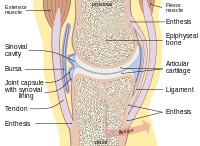
Photo from wikipedia
Introduction Inactive squamosal disease is unique for having a conflicting treatment protocol, with an age-old debate between early surgical intervention or keeping patients in a long-term follow-up. The shifting paradigm… Click to show full abstract
Introduction Inactive squamosal disease is unique for having a conflicting treatment protocol, with an age-old debate between early surgical intervention or keeping patients in a long-term follow-up. The shifting paradigm is early intervention to prevent further progress into active disease and improve hearing outcome in its nascent stage. Objective To evaluate recurrence and hearing outcome in cases of inactive squamosal disease after cartilage strengthening tympanoplasty. Methods The study was conducted on 50 patients with inactive squamosal disease. Detailed examination was done to grade the retraction. All patients underwent autologous conchal cartilage tympanomastoidectomy with temporalis fascia grafting. Recurrence and hearing evaluations were done by pure tone audiogram at regular intervals for one year. Results Hearing loss was the most common presenting symptom. Isolated pars tensa retractions were more common (54%) than pars flaccida (12%), or those involving both (34%). Ossicular status was normal in only 14% of the cases, and the most common ossicular damage was to the lenticular process of the incus (52%). Three of the patients (6%) had residual perforation at the 3 rd month of follow-up. Subjective improvement in hearing was reported by 42% patients. Hearing improvement greater than 10 dB was found in 24 patients (48%). Air–bone gap reduced from 25.16 ± 8.15 dB preoperatively to 12.90 ± 6.20 at 1 year of follow-up. Recurrence was seen in three patients (6%). Conclusion Early intervention by cartilage strengthening of weakened tympanic membrane and ossicular reconstruction not only offers better hearing results, but also prevents progress to active disease.
Journal Title: International Archives of Otorhinolaryngology
Year Published: 2022
Link to full text (if available)
Share on Social Media: Sign Up to like & get
recommendations!